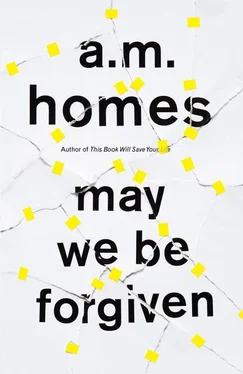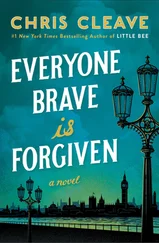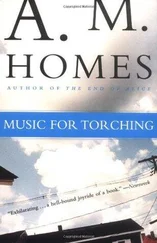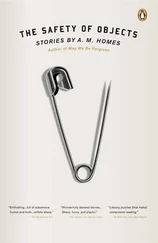“A bribe?” I suggest.
“My wife loves the stuff,” Crawley says. “She grew up on it.” He pulls himself together. “Okay, so Walter here is going to tell us a bit about the program he’s been working on — and I can tell you that, while we’ve not placed anyone in it before, I’ve been talking with lots of folks about options for George, and short of either a classic loony bin or jail, there’s not a lot out there. And I honestly don’t think either of those would be right for George.”
“May I?” Walter asks.
“Please,” Dr. Crawley says.
“We’re always exploring new concepts in criminal justice, everything from the architecture of prison structures to the psychological experience of punishment. The Woodsman is an experiment that can be boiled down to a low-cost survival-of-the-fittest model. And while George isn’t the typical candidate, we think he’s a viable candidate and this could be a strong placement option.”
“Who is your typical candidate?” I ask.
“Someone with more of a criminal history, rural as opposed to urban experience, not much white-collar, more robbery, grand theft, a little murder. A man good with his hands who needs physical challenge. We’ve found that violent men are less likely to behave violently in a natural setting. When they’re up against the elements, they train themselves, they self-regulate — they see it as man versus the land, instead of man versus man. We have no serial killers — we think of that as a very different profile, and as much as we have a legal mandate to punish, we also have to respect the inalienable rights of our prisoners and not put them at undue risk. Essentially, The Woodsman is designed as an inexpensive self-policing penal colony. As you may know, there is a long history for a self-sustaining prison farm, as well as the Quaker model. They built the first penitentiary, which included the need to look towards the sky.” Walter in fact looks up as he speaks. “In essence, see the light, be with God, and repent!”
“You sound almost like a minister when you say that,” the medical director notes.
“Thank you,” Walter Penny says.
“Could you be a little more specific? The way you’ve described it so far, it sounds like an episode of Mutual of Omaha’s Wild Kingdom, ” I say.
“Show him the PowerPoint,” Crawley urges.
“Of course,” Walter says, tilting the screen of his laptop towards me. “A quick bit of background to keep in mind: the cost per prisoner in New York is more than fifty thousand dollars per year, the cost per prisoner in our program is less than ten thousand per man.” He pushes the start button. A macho logo comes on-screen, “THE WOODSMAN,” followed by intense heavy-metal music and a highly produced video rollout that looks like a commercial for joining the army or the National Guard. The “sample” inmates—“Tough, Strong, Willful, Resistant”—are shown climbing trees, fishing for their own food in a river, rappelling off a rock wall. All using the carefully selected supplies provided in their Woodsman pack, which is given to them upon launch into the program and replaced annually. It closes with the disclaimer that “The Woodsman is a back-to-basics model for human management using the Physics 300a or 300b microchip, tracked by satellite, with the 300b chip also providing a constant read of vital signs. Should there be any kind of uprising or behavior problem, it can be neutralized either temporarily or permanently by drone or computer-assisted power shot within one to five minutes.”
“That’s pretty much it,” Walter Penny says. “The prisoners are microchipped and released onto a forty-five-hundred-acre parcel, a former military testing facility. There are no live munitions there, but enough infrastructure so that we can run some back-office activities from the underground bunker and so on. There are shelters for sleep, the prisoners farm and forage, and there is a central structure above the bunker where they can come and do laundry, bathe, and restock their supplies — we have government cheese, surplus foods including peanut butter and milk, and water on hand. We’re testing a new doc-in-a-box system by which routine medications can be dispensed and medical conditions can be tracked via a robotic field medic who can take temperature, blood pressure, EKG, and draw blood if needed. In the winter — each man has a solar yurt.”
“So it’s like a tag-and-release wildlife refuge — only the wildlife is human?” I ask.
“Yep,” Walter says. “This is a highly monitored safe zone — we have it under twenty-four-hour observation.”
“What if one of the guys goes after another?”
“We know where they are and what they’re doing at all times — we monitor them around the clock. And discipline, if needed, is swift and unforgiving.”
“From above,” the medical director says, like he’s drunk the Kool-Aid.
“That’s right — a drone is launched, and that’s all she wrote.”
“What if they manage to leave the chip behind and escape?”
“They’re chipped at the back of the neck; there’s no way to remove it without losing cerebral function. If one kills another, we know exactly who did it and how and, zippity-boom-bah, here comes the predator drone.”
“And do these men eventually graduate from your program?”
“And do what?” Walter Penny asks, caught off guard.
I shrug. “Become park rangers?”
“These are bad men,” Walter says, like I’ve missed the point all along.
“Do they escape?”
“The men and their representatives sign a contract going in which says we can Taser, shock, or execute as needed. We’re judicious re discipline; mostly we haven’t had to.”
“And do the men make friends?”
Walter shakes his head like it’s all been lost on me. “This isn’t exactly your campfire, ‘Kumbaya,’ and melted-marshmallow crowd.”
“So — why do you think this would be a good place for George?”
“I’ll take that one,” the medical director says. “George has a lot of anger and excess energy, and he very much likes to be the boss.”
“I just want to jump in for a moment,” Manny says, “and color things in a bit for you. As per what we were talking about earlier, if we settle on this program, if we agree that this is the place for George, the placement would be considered a deal. A deal mitigates the need for George going to trial, which would be a lengthy, expensive, and very public process.”
“You’re saying that if we send George off into the woods — there’s no trial?”
“Correct,” Walter Penny says.
“How long would he have to stay in the woods?”
“Hard to tell, but any subsequent placement would be covered under this agreement — it’s not like he’d come out of the woods and have to go to trial,” Manny says.
“Let me be honest with you,” Walter Penny says. “It would be good for us to have a few higher-profile cases. It keeps us on the map — we got the initial funding, and while the cost is amazingly low per prisoner as compared with a traditional facility, we need some good PR to stay up and running.”
“It certainly looks like a lot of money was spent on your logo and presentation.”
“Branding is everything these days,” Walter says. “We had a couple of really nice grants to get us going — but now we’re on our own.”
“Just to review,” Manny jumps in, cutting off what I think is a fascinating conversation about who gave them a grant to come up with the wood-grained/green logo. “The terms of the placement are as follows: We accept the placement in The Woodsman as a one-time-only offer; the offer and acceptance are not precedential, and any further placement following the first forty-eight hours at The Woodsman facility is to be considered under the umbrella of this agreement and is not subject to revocation. It is understood that time spent in The Woodsman program is covered by the laws of the state in which the facility is based and the laws of the United States and subject to due process, et cetera. Further, the costs of the move from the private facility, The Lodge, to a public facility, The Woodsman, will be borne by The Lodge as a ‘give’ due to the closure of the facility.”
Читать дальше












